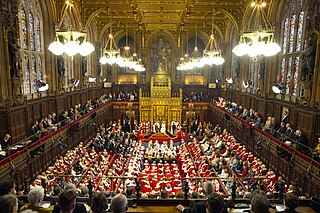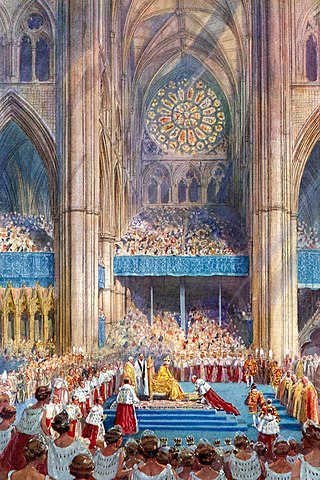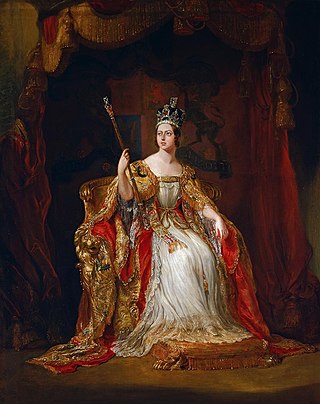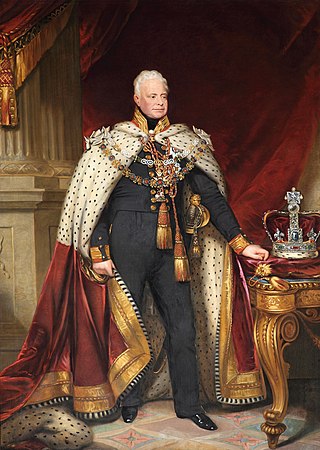
The Palace of Westminster is the meeting place of the Parliament of the United Kingdom and is located in London, England. It is commonly called the Houses of Parliament after the House of Commons and the House of Lords, the two legislative chambers which occupy the building. The palace is the centre of political life in the United Kingdom; "Westminster" has become a metonym for the UK Parliament and the British Government, and the Westminster system of government commemorates the name of the palace. The clock bell in the Elizabeth Tower of the palace, nicknamed Big Ben, is a landmark of London and the United Kingdom in general. The Palace of Westminster has been a Grade I listed building since 1970 and part of a UNESCO World Heritage Site since 1987.

The State Opening of Parliament is a ceremonial event which formally marks the beginning of each session of the Parliament of the United Kingdom. At its core is His Majesty's "gracious speech from the throne", which is read by the monarch but written by HM Government. In the speech the monarch gives notice of forthcoming state visits, before setting out the government's legislative programme for the new parliamentary session. No business of either House of Parliament can proceed until the Sovereign’s speech has been delivered.

The Crown Jewels of the United Kingdom, originally the Crown Jewels of England, are a collection of royal ceremonial objects kept in the Jewel House at the Tower of London, which include the coronation regalia and vestments worn by British monarchs.

The coronation of the monarch of the United Kingdom is an initiation ceremony in which they are formally invested with regalia and crowned at Westminster Abbey. It corresponds to the coronations that formerly took place in other European monarchies, which have all abandoned coronations in favour of inauguration or enthronement ceremonies. A coronation is a symbolic formality and does not signify the official beginning of the monarch's reign; de jure and de facto their reign commences from the moment of the preceding monarch's death or abdication, maintaining legal continuity of the monarchy.

The Lord Speaker of the House of Lords is the presiding officer, chairman and highest authority of the House of Lords in the Parliament of the United Kingdom. The office is analogous to the Speaker of the House of Commons: the Lord Speaker is elected by the members of the House of Lords and is expected to be politically impartial.

The Irish State Coach is an enclosed, four-horse-drawn carriage used by the British Royal Family. It is the traditional horse-drawn coach in which the British monarch travels from Buckingham Palace to the Palace of Westminster to formally open the new legislative session of the UK Parliament.
The High Constables of Holyroodhouse are a small corps of ceremonial bodyguards at the Sovereign's official residence in the Scottish capital, Edinburgh. Created in the early sixteenth century to protect the Monarch in residence at Holyrood, as well as to guard the Palace and Abbey, and enforce law and order within the precincts of the Palace and the Holyrood Abbey Sanctuary.
Lords-in-waiting (male) or baronesses-in-waiting (female) are peers who hold office in the Royal Household of the sovereign of the United Kingdom. In the official Court Circular they are styled "Lord in Waiting" or "Baroness in Waiting".

Typical of British heraldry, a cap of maintenance, known in heraldic language as a chapeau gules turned up ermine, is a ceremonial cap of crimson velvet lined with ermine, which is worn or carried by certain persons as a sign of nobility or special honour. It is worn with the high part to the fore, and the tapering tail behind. It may substitute for the torse in the heraldic achievement of a person of special honour granted the privilege by the monarch. It thus appears in such cases on top of the helm and below the crest. It does not, however, feature in the present royal coat of arms of the United Kingdom, which shows the royal crest upon the royal crown, itself upon the royal helmet.

Old Palace Yard is a paved open space in the City of Westminster in Central London, England. It lies between the Palace of Westminster to its north and east and Westminster Abbey to its west. It is known as the site of executions, including those of Sir Walter Raleigh, Guy Fawkes and other conspirators of the Gunpowder Plot, and James Hamilton, 1st Duke of Hamilton, following the Battle of Preston.

The coronation of Elizabeth II as queen of the United Kingdom and the other Commonwealth realms took place on 2 June 1953 at Westminster Abbey in London. She acceded to the throne at the age of 25 upon the death of her father, George VI, on 6 February 1952, being proclaimed queen by her privy and executive councils shortly afterwards. The coronation was held more than one year later because of the tradition of allowing an appropriate length of time to pass after a monarch dies. It also gave the planning committees adequate time to make preparations for the ceremony. During the service, Elizabeth took an oath, was anointed with holy oil, was invested with robes and regalia, and was crowned Queen of the United Kingdom, Canada, Australia, New Zealand, South Africa, Pakistan, and Ceylon.

In the United Kingdom, state funerals are usually reserved for monarchs. The most recent was the state funeral of Queen Elizabeth II on 19 September 2022.

The Speaker's State Coach is the oldest of the three great State Coaches of the United Kingdom. Like the Gold State Coach and the Lord Mayor of London's State Coach it is elaborately carved and gilded, and is decorated with allegorical paintings by G. B. Cipriani.

The coronation of Victoria as Queen of the United Kingdom took place on Thursday, 28 June 1838, just over a year after she succeeded to the throne of the United Kingdom at the age of 18. The ceremony was held in Westminster Abbey after a public procession through the streets from Buckingham Palace, to which the Queen returned later as part of a second procession.

The coronation of George VI and his wife, Elizabeth, as king and queen of the United Kingdom and the Dominions of the British Commonwealth, Emperor and Empress consort of India took place at Westminster Abbey, London, on Wednesday 12 May 1937. George VI ascended the throne upon the abdication of his brother, Edward VIII, on 11 December 1936, three days before his 41st birthday. Edward's coronation had been planned for 12 May and it was decided to continue with his brother and sister-in-law's coronation on the same date.

The coronation of William IV and his wife, Adelaide, as King and Queen of the United Kingdom took place on Thursday, 8 September 1831, over fourteen months after he succeeded to the throne of the United Kingdom at the age of 64, the oldest person to assume the throne until Charles III in 2022. The ceremony was held in Westminster Abbey after a public procession through the streets from St James's Palace, to which the King and Queen returned later as part of a second procession.

The coronation of George IV as King of the United Kingdom took place at Westminster Abbey, London, on 19 July 1821. Originally scheduled for 1 August of the previous year, the ceremony had been postponed due to the parliamentary proceedings of George's estranged wife, Queen Caroline; because these failed to deprive Queen Caroline of her titles and obtain a divorce from the King, she was excluded from the ceremony. In accordance with George's lavish personal tastes, the coronation was the most extravagant ever staged and a number of the traditional elements of the ceremonial were conducted for the last time.

On 6 February 1952, George VI, King of the United Kingdom, died at the age of 56, at Sandringham House, after battling with a prolonged cancer. His state funeral took place on 15 February 1952. A period of national mourning commenced and his eldest daughter and successor, Queen Elizabeth II was proclaimed the new monarch by the Accession Council. George VI's coffin lay in St Mary Magdalene Church, Sandringham until 11 February when it was carried, in procession, to the nearby Wolferton railway station. The coffin was carried by train to London King's Cross railway station where another formal procession carried it to Westminster Hall where the king lay in state for three days. Some 304,000 people passed through Westminster Hall with queues up to 4 miles (6.4 km) forming.

The coronation of George III and his wife Charlotte as King and Queen of Great Britain and Ireland took place at Westminster Abbey, London, on Tuesday, 22 September 1761, about two weeks after they were married in the Chapel Royal, St James's Palace. The day was marked by errors and omissions; a delayed procession from Westminster Hall to the abbey was followed by a six-hour coronation service and then a banquet that finally ended at ten o'clock at night.

The coronation of James II and VII, and his wife Mary of Modena, as King and Queen of England, Scotland and Ireland was held on 23 April 1685 at Westminster Abbey. James and Mary were the last British monarchs to be Catholics, despite the Protestant Church of England being the established church. Accordingly, the service was reordered to omit the Anglican Communion Service, the only time that a British coronation has been conducted without one. The truncated text of the coronation liturgy which was prepared for the service provided the model for future coronations into the 20th century. James was also the first monarch since the Union of the Crowns not to have a coronation in Scotland, and the first English monarch since the 14th century not to plan a royal entry procession through London, these and other innovations set long-standing precedents for future British coronations.




















